Future of UAVs in Commerce and Defense: Opportunities and Challenges
VerifiedAdded on 2020/04/07
|12
|1921
|64
AI Summary
The commercial drone industry is projected to exceed $2 billion by 2022, driven by technological advancements and diverse applications across sectors. Key players include DJI Innovations, Yuneec International, 3D Robotics, GoPro Inc., and Parrot SA. The military sub-industry remains a dominant force due to its secretive technology development. Competitive dynamics are influenced by the bargaining powers of suppliers and customers. Suppliers have less power as more companies enter the market, while consumers possess significant influence due to product variety and pricing flexibility. The industry faces minimal threat from substitutes, as drones increasingly replace human tasks in various sectors, enhancing demand. This analysis highlights the strategic elements shaping the commercial drone landscape.
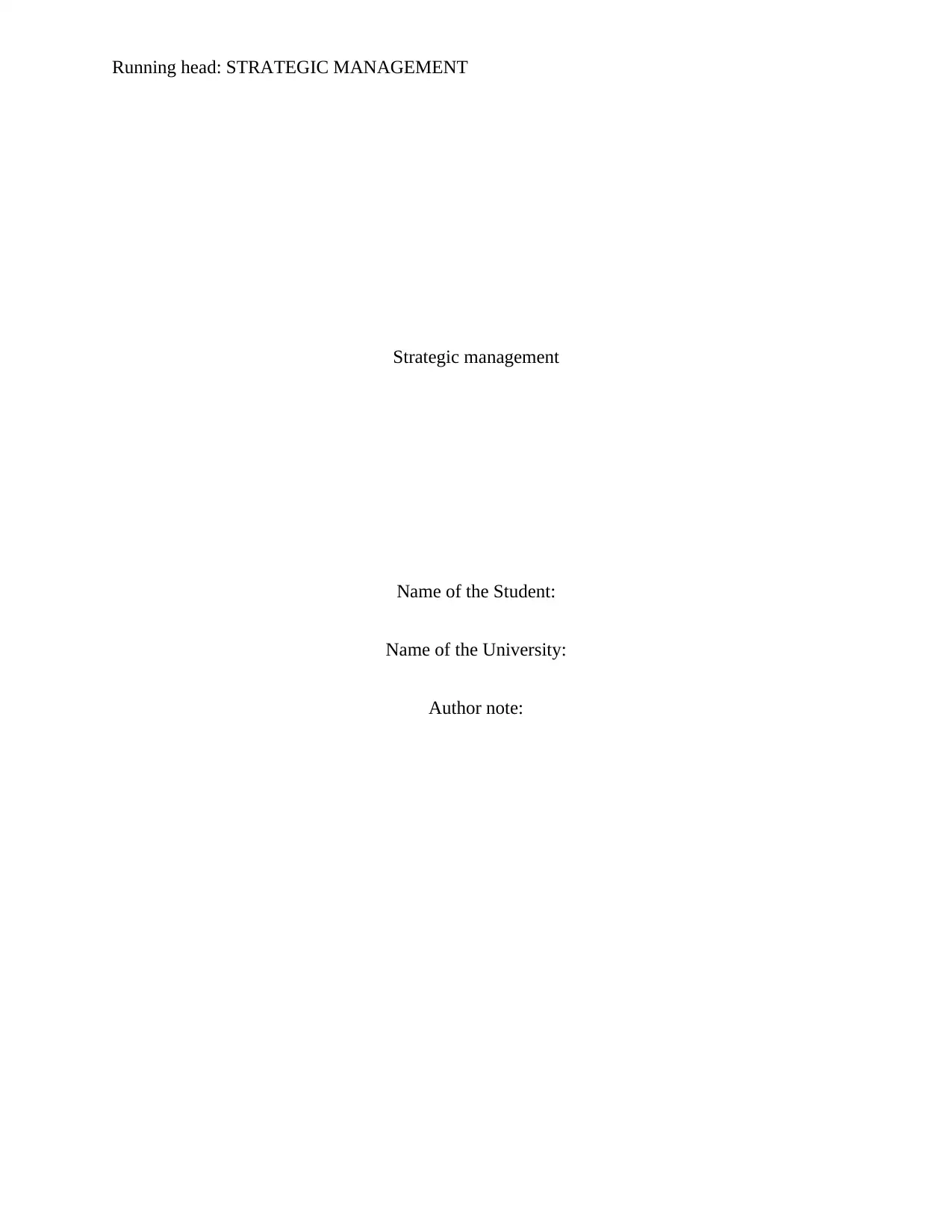
Running head: STRATEGIC MANAGEMENT
Strategic management
Name of the Student:
Name of the University:
Author note:
Strategic management
Name of the Student:
Name of the University:
Author note:
Paraphrase This Document
Need a fresh take? Get an instant paraphrase of this document with our AI Paraphraser
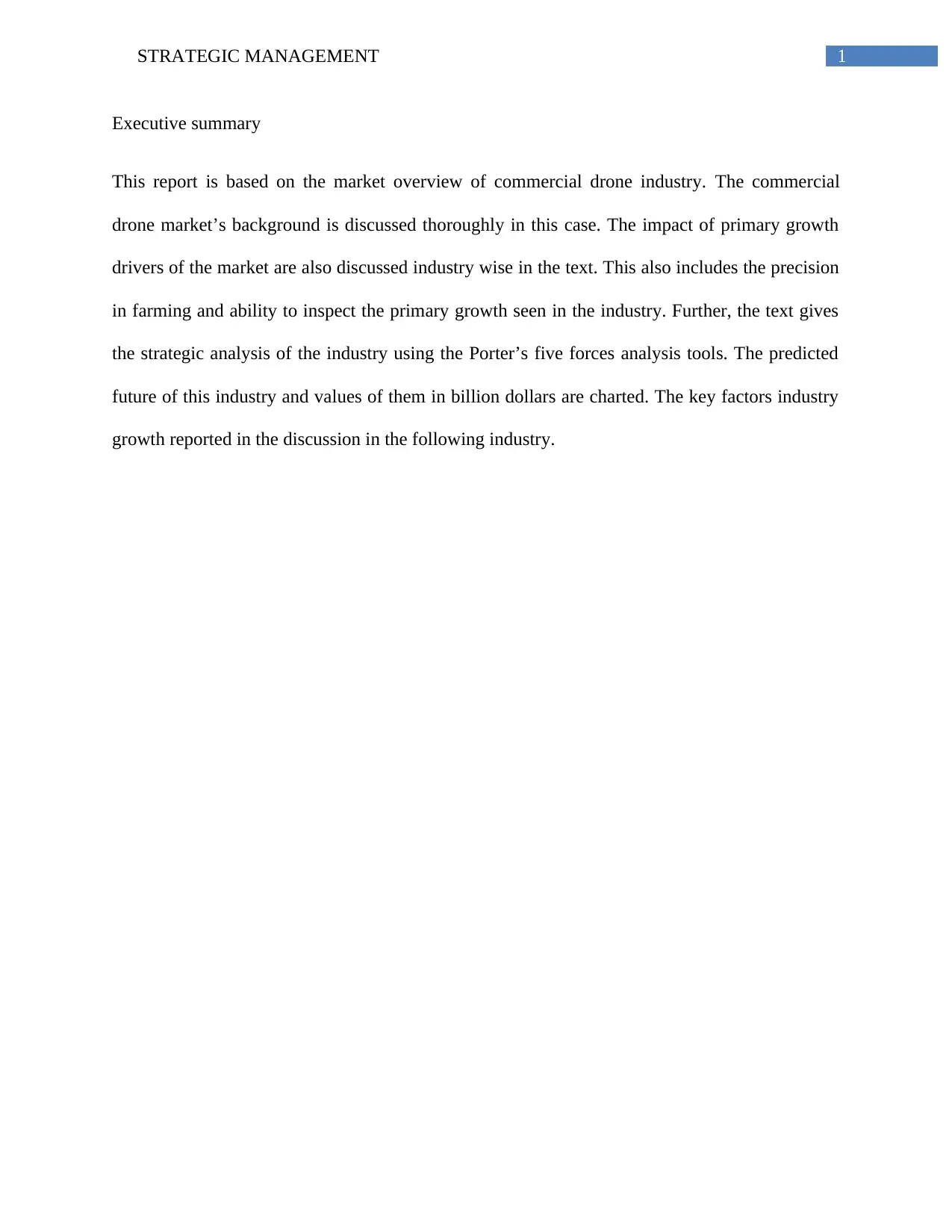
1STRATEGIC MANAGEMENT
Executive summary
This report is based on the market overview of commercial drone industry. The commercial
drone market’s background is discussed thoroughly in this case. The impact of primary growth
drivers of the market are also discussed industry wise in the text. This also includes the precision
in farming and ability to inspect the primary growth seen in the industry. Further, the text gives
the strategic analysis of the industry using the Porter’s five forces analysis tools. The predicted
future of this industry and values of them in billion dollars are charted. The key factors industry
growth reported in the discussion in the following industry.
Executive summary
This report is based on the market overview of commercial drone industry. The commercial
drone market’s background is discussed thoroughly in this case. The impact of primary growth
drivers of the market are also discussed industry wise in the text. This also includes the precision
in farming and ability to inspect the primary growth seen in the industry. Further, the text gives
the strategic analysis of the industry using the Porter’s five forces analysis tools. The predicted
future of this industry and values of them in billion dollars are charted. The key factors industry
growth reported in the discussion in the following industry.
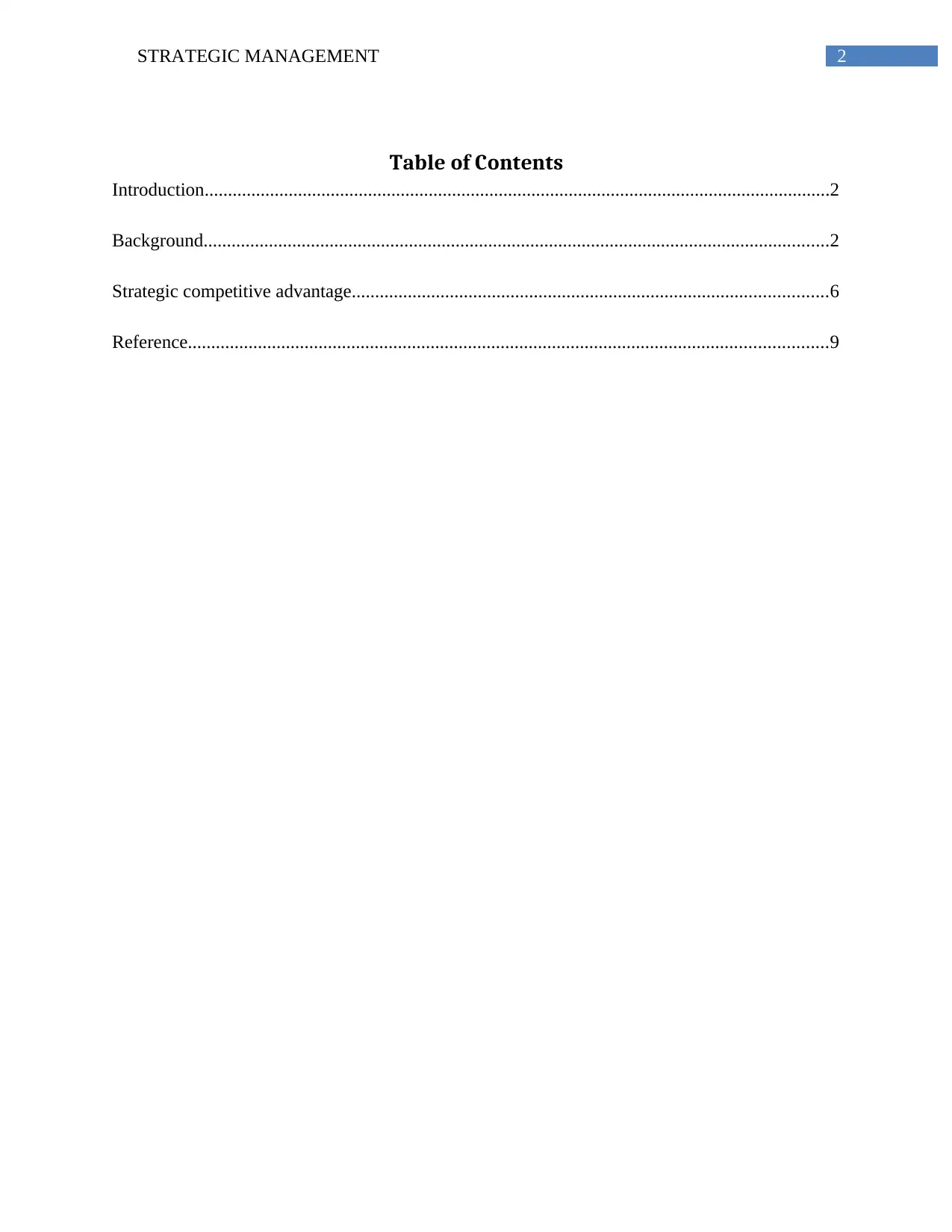
2STRATEGIC MANAGEMENT
Table of Contents
Introduction......................................................................................................................................2
Background......................................................................................................................................2
Strategic competitive advantage......................................................................................................6
Reference.........................................................................................................................................9
Table of Contents
Introduction......................................................................................................................................2
Background......................................................................................................................................2
Strategic competitive advantage......................................................................................................6
Reference.........................................................................................................................................9
⊘ This is a preview!⊘
Do you want full access?
Subscribe today to unlock all pages.

Trusted by 1+ million students worldwide
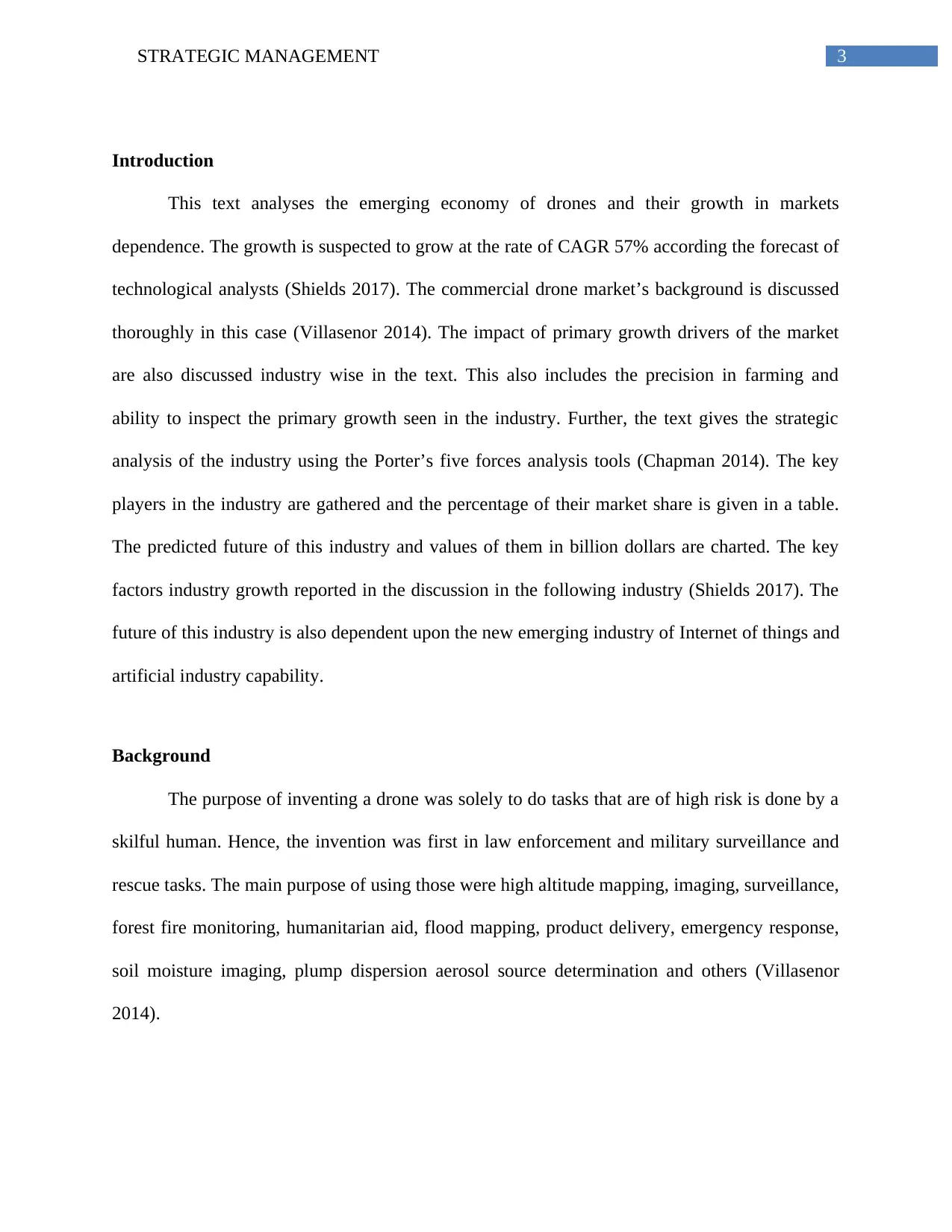
3STRATEGIC MANAGEMENT
Introduction
This text analyses the emerging economy of drones and their growth in markets
dependence. The growth is suspected to grow at the rate of CAGR 57% according the forecast of
technological analysts (Shields 2017). The commercial drone market’s background is discussed
thoroughly in this case (Villasenor 2014). The impact of primary growth drivers of the market
are also discussed industry wise in the text. This also includes the precision in farming and
ability to inspect the primary growth seen in the industry. Further, the text gives the strategic
analysis of the industry using the Porter’s five forces analysis tools (Chapman 2014). The key
players in the industry are gathered and the percentage of their market share is given in a table.
The predicted future of this industry and values of them in billion dollars are charted. The key
factors industry growth reported in the discussion in the following industry (Shields 2017). The
future of this industry is also dependent upon the new emerging industry of Internet of things and
artificial industry capability.
Background
The purpose of inventing a drone was solely to do tasks that are of high risk is done by a
skilful human. Hence, the invention was first in law enforcement and military surveillance and
rescue tasks. The main purpose of using those were high altitude mapping, imaging, surveillance,
forest fire monitoring, humanitarian aid, flood mapping, product delivery, emergency response,
soil moisture imaging, plump dispersion aerosol source determination and others (Villasenor
2014).
Introduction
This text analyses the emerging economy of drones and their growth in markets
dependence. The growth is suspected to grow at the rate of CAGR 57% according the forecast of
technological analysts (Shields 2017). The commercial drone market’s background is discussed
thoroughly in this case (Villasenor 2014). The impact of primary growth drivers of the market
are also discussed industry wise in the text. This also includes the precision in farming and
ability to inspect the primary growth seen in the industry. Further, the text gives the strategic
analysis of the industry using the Porter’s five forces analysis tools (Chapman 2014). The key
players in the industry are gathered and the percentage of their market share is given in a table.
The predicted future of this industry and values of them in billion dollars are charted. The key
factors industry growth reported in the discussion in the following industry (Shields 2017). The
future of this industry is also dependent upon the new emerging industry of Internet of things and
artificial industry capability.
Background
The purpose of inventing a drone was solely to do tasks that are of high risk is done by a
skilful human. Hence, the invention was first in law enforcement and military surveillance and
rescue tasks. The main purpose of using those were high altitude mapping, imaging, surveillance,
forest fire monitoring, humanitarian aid, flood mapping, product delivery, emergency response,
soil moisture imaging, plump dispersion aerosol source determination and others (Villasenor
2014).
Paraphrase This Document
Need a fresh take? Get an instant paraphrase of this document with our AI Paraphraser
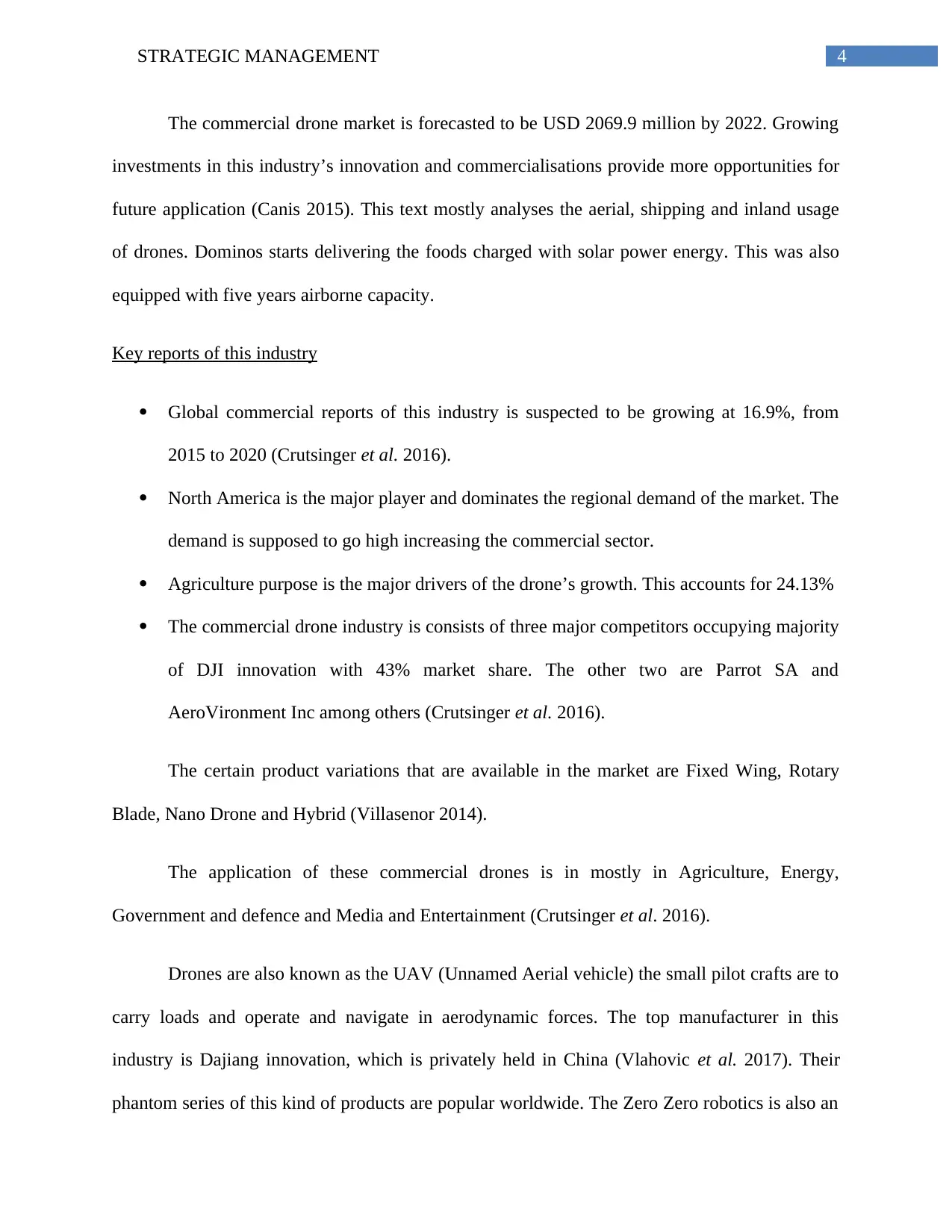
4STRATEGIC MANAGEMENT
The commercial drone market is forecasted to be USD 2069.9 million by 2022. Growing
investments in this industry’s innovation and commercialisations provide more opportunities for
future application (Canis 2015). This text mostly analyses the aerial, shipping and inland usage
of drones. Dominos starts delivering the foods charged with solar power energy. This was also
equipped with five years airborne capacity.
Key reports of this industry
Global commercial reports of this industry is suspected to be growing at 16.9%, from
2015 to 2020 (Crutsinger et al. 2016).
North America is the major player and dominates the regional demand of the market. The
demand is supposed to go high increasing the commercial sector.
Agriculture purpose is the major drivers of the drone’s growth. This accounts for 24.13%
The commercial drone industry is consists of three major competitors occupying majority
of DJI innovation with 43% market share. The other two are Parrot SA and
AeroVironment Inc among others (Crutsinger et al. 2016).
The certain product variations that are available in the market are Fixed Wing, Rotary
Blade, Nano Drone and Hybrid (Villasenor 2014).
The application of these commercial drones is in mostly in Agriculture, Energy,
Government and defence and Media and Entertainment (Crutsinger et al. 2016).
Drones are also known as the UAV (Unnamed Aerial vehicle) the small pilot crafts are to
carry loads and operate and navigate in aerodynamic forces. The top manufacturer in this
industry is Dajiang innovation, which is privately held in China (Vlahovic et al. 2017). Their
phantom series of this kind of products are popular worldwide. The Zero Zero robotics is also an
The commercial drone market is forecasted to be USD 2069.9 million by 2022. Growing
investments in this industry’s innovation and commercialisations provide more opportunities for
future application (Canis 2015). This text mostly analyses the aerial, shipping and inland usage
of drones. Dominos starts delivering the foods charged with solar power energy. This was also
equipped with five years airborne capacity.
Key reports of this industry
Global commercial reports of this industry is suspected to be growing at 16.9%, from
2015 to 2020 (Crutsinger et al. 2016).
North America is the major player and dominates the regional demand of the market. The
demand is supposed to go high increasing the commercial sector.
Agriculture purpose is the major drivers of the drone’s growth. This accounts for 24.13%
The commercial drone industry is consists of three major competitors occupying majority
of DJI innovation with 43% market share. The other two are Parrot SA and
AeroVironment Inc among others (Crutsinger et al. 2016).
The certain product variations that are available in the market are Fixed Wing, Rotary
Blade, Nano Drone and Hybrid (Villasenor 2014).
The application of these commercial drones is in mostly in Agriculture, Energy,
Government and defence and Media and Entertainment (Crutsinger et al. 2016).
Drones are also known as the UAV (Unnamed Aerial vehicle) the small pilot crafts are to
carry loads and operate and navigate in aerodynamic forces. The top manufacturer in this
industry is Dajiang innovation, which is privately held in China (Vlahovic et al. 2017). Their
phantom series of this kind of products are popular worldwide. The Zero Zero robotics is also an
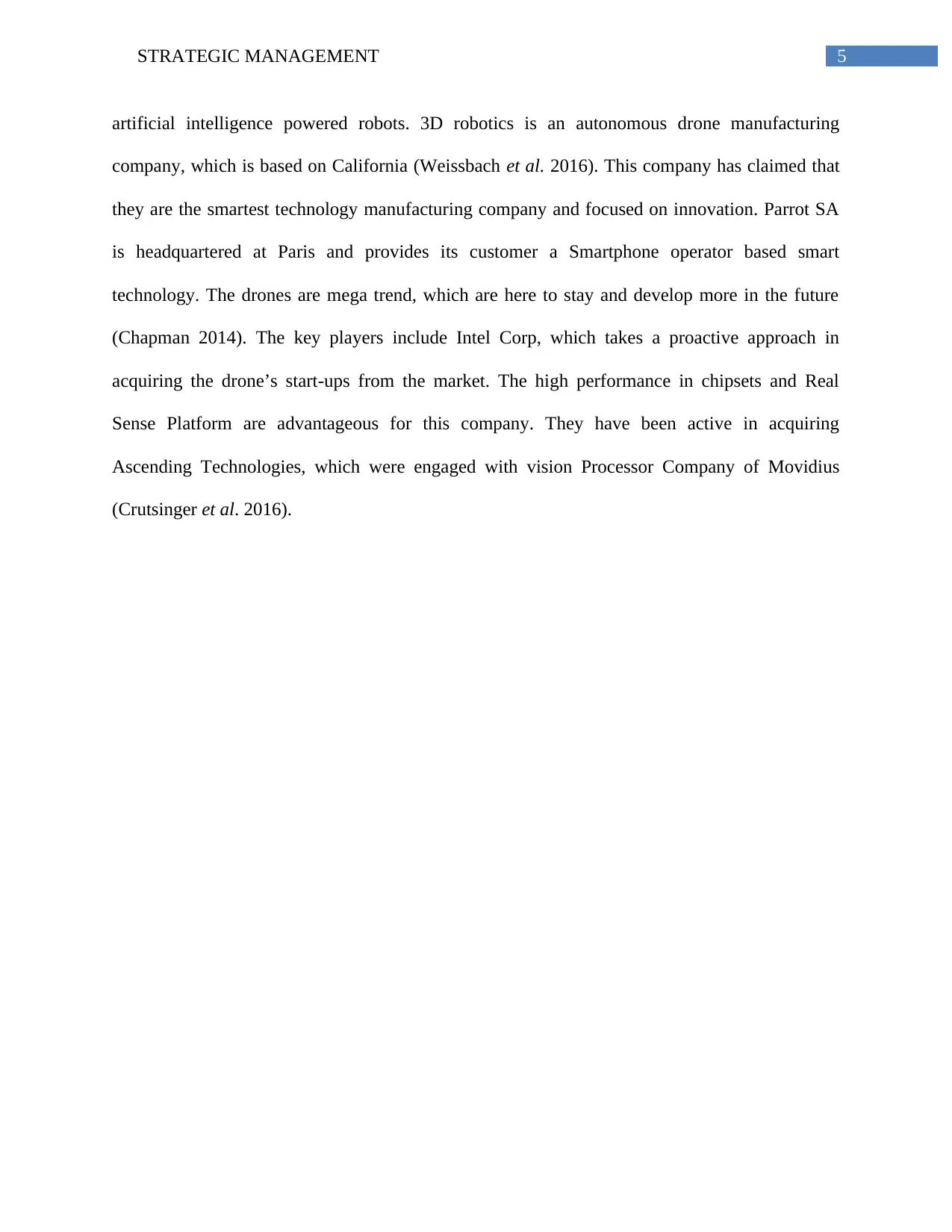
5STRATEGIC MANAGEMENT
artificial intelligence powered robots. 3D robotics is an autonomous drone manufacturing
company, which is based on California (Weissbach et al. 2016). This company has claimed that
they are the smartest technology manufacturing company and focused on innovation. Parrot SA
is headquartered at Paris and provides its customer a Smartphone operator based smart
technology. The drones are mega trend, which are here to stay and develop more in the future
(Chapman 2014). The key players include Intel Corp, which takes a proactive approach in
acquiring the drone’s start-ups from the market. The high performance in chipsets and Real
Sense Platform are advantageous for this company. They have been active in acquiring
Ascending Technologies, which were engaged with vision Processor Company of Movidius
(Crutsinger et al. 2016).
artificial intelligence powered robots. 3D robotics is an autonomous drone manufacturing
company, which is based on California (Weissbach et al. 2016). This company has claimed that
they are the smartest technology manufacturing company and focused on innovation. Parrot SA
is headquartered at Paris and provides its customer a Smartphone operator based smart
technology. The drones are mega trend, which are here to stay and develop more in the future
(Chapman 2014). The key players include Intel Corp, which takes a proactive approach in
acquiring the drone’s start-ups from the market. The high performance in chipsets and Real
Sense Platform are advantageous for this company. They have been active in acquiring
Ascending Technologies, which were engaged with vision Processor Company of Movidius
(Crutsinger et al. 2016).
⊘ This is a preview!⊘
Do you want full access?
Subscribe today to unlock all pages.

Trusted by 1+ million students worldwide
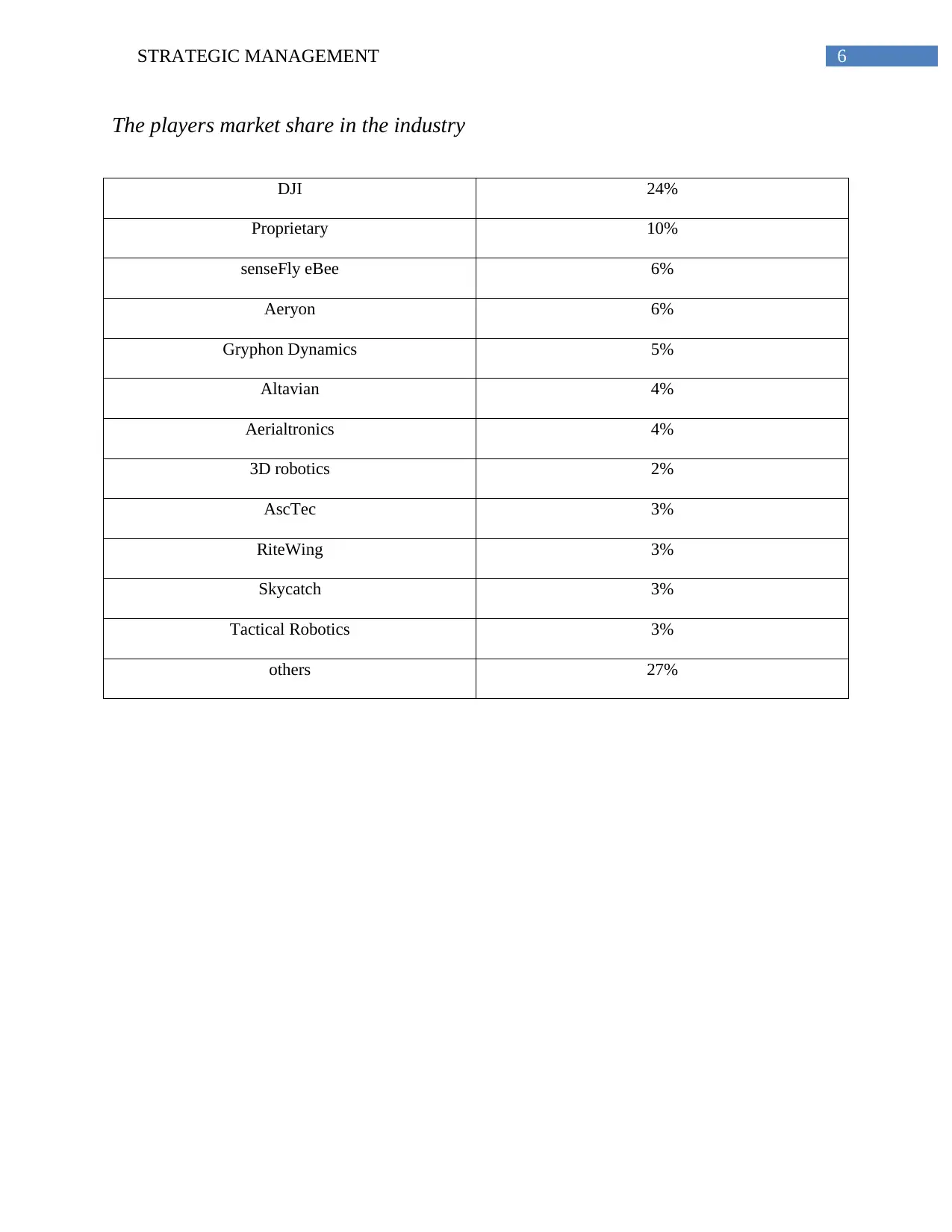
6STRATEGIC MANAGEMENT
The players market share in the industry
DJI 24%
Proprietary 10%
senseFly eBee 6%
Aeryon 6%
Gryphon Dynamics 5%
Altavian 4%
Aerialtronics 4%
3D robotics 2%
AscTec 3%
RiteWing 3%
Skycatch 3%
Tactical Robotics 3%
others 27%
The players market share in the industry
DJI 24%
Proprietary 10%
senseFly eBee 6%
Aeryon 6%
Gryphon Dynamics 5%
Altavian 4%
Aerialtronics 4%
3D robotics 2%
AscTec 3%
RiteWing 3%
Skycatch 3%
Tactical Robotics 3%
others 27%
Paraphrase This Document
Need a fresh take? Get an instant paraphrase of this document with our AI Paraphraser
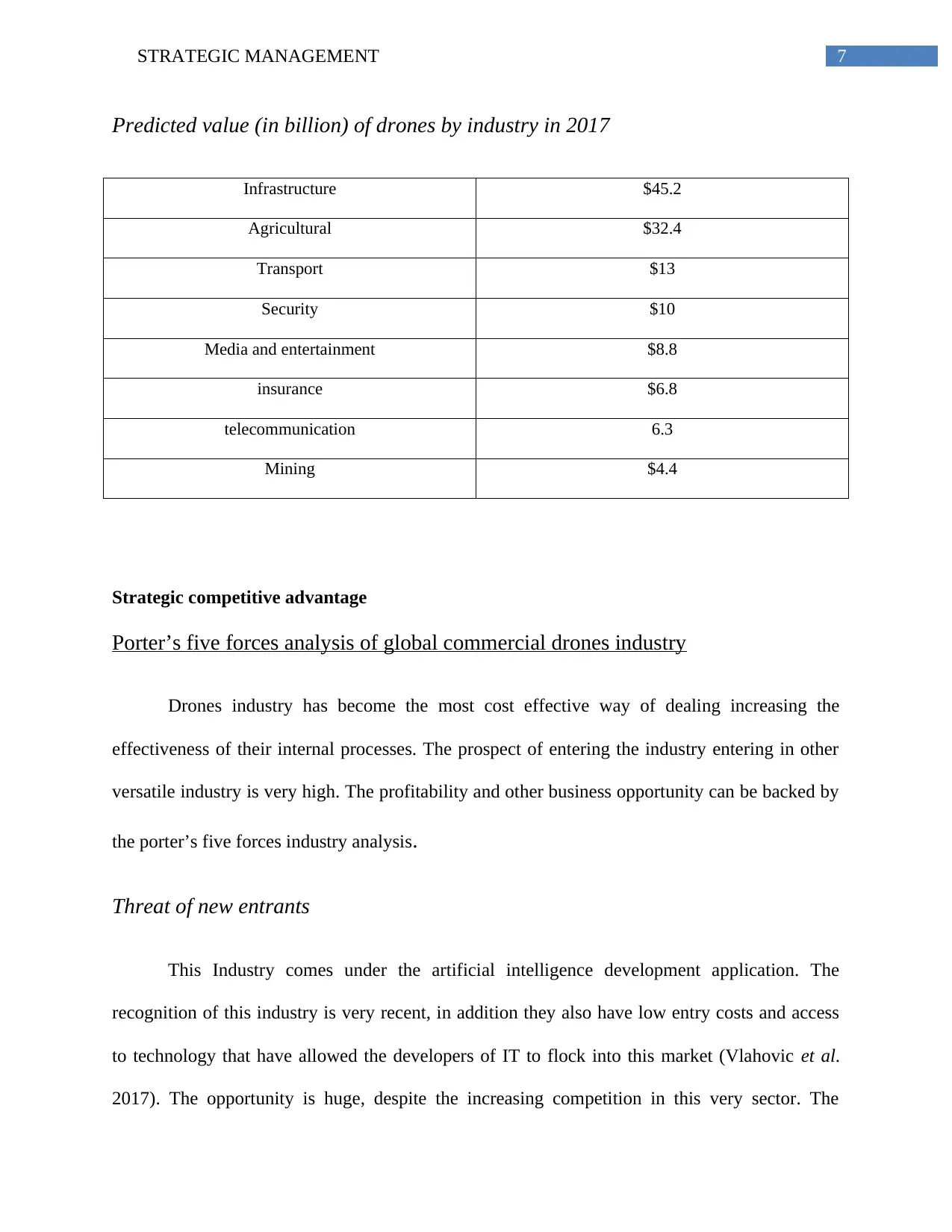
7STRATEGIC MANAGEMENT
Predicted value (in billion) of drones by industry in 2017
Infrastructure $45.2
Agricultural $32.4
Transport $13
Security $10
Media and entertainment $8.8
insurance $6.8
telecommunication 6.3
Mining $4.4
Strategic competitive advantage
Porter’s five forces analysis of global commercial drones industry
Drones industry has become the most cost effective way of dealing increasing the
effectiveness of their internal processes. The prospect of entering the industry entering in other
versatile industry is very high. The profitability and other business opportunity can be backed by
the porter’s five forces industry analysis.
Threat of new entrants
This Industry comes under the artificial intelligence development application. The
recognition of this industry is very recent, in addition they also have low entry costs and access
to technology that have allowed the developers of IT to flock into this market (Vlahovic et al.
2017). The opportunity is huge, despite the increasing competition in this very sector. The
Predicted value (in billion) of drones by industry in 2017
Infrastructure $45.2
Agricultural $32.4
Transport $13
Security $10
Media and entertainment $8.8
insurance $6.8
telecommunication 6.3
Mining $4.4
Strategic competitive advantage
Porter’s five forces analysis of global commercial drones industry
Drones industry has become the most cost effective way of dealing increasing the
effectiveness of their internal processes. The prospect of entering the industry entering in other
versatile industry is very high. The profitability and other business opportunity can be backed by
the porter’s five forces industry analysis.
Threat of new entrants
This Industry comes under the artificial intelligence development application. The
recognition of this industry is very recent, in addition they also have low entry costs and access
to technology that have allowed the developers of IT to flock into this market (Vlahovic et al.
2017). The opportunity is huge, despite the increasing competition in this very sector. The
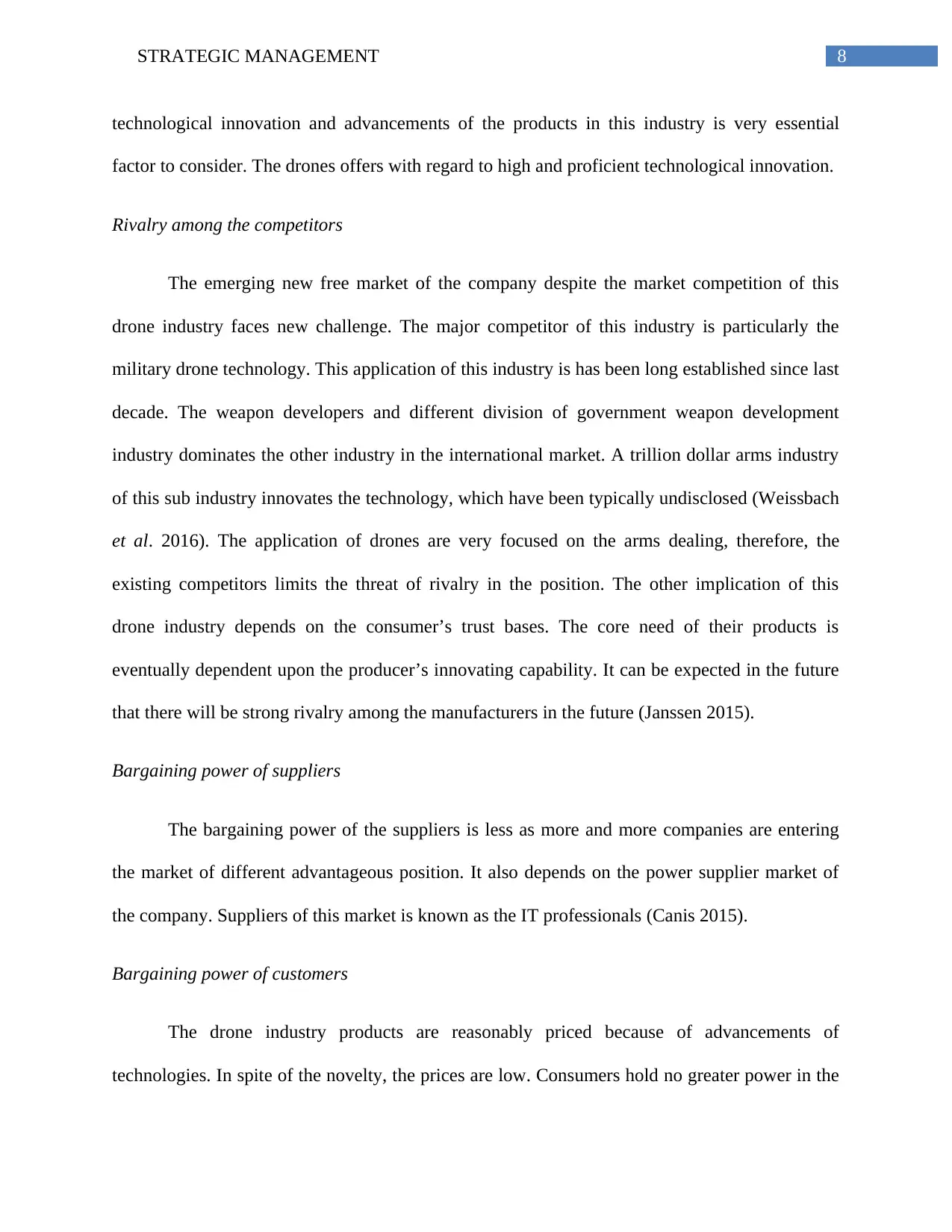
8STRATEGIC MANAGEMENT
technological innovation and advancements of the products in this industry is very essential
factor to consider. The drones offers with regard to high and proficient technological innovation.
Rivalry among the competitors
The emerging new free market of the company despite the market competition of this
drone industry faces new challenge. The major competitor of this industry is particularly the
military drone technology. This application of this industry is has been long established since last
decade. The weapon developers and different division of government weapon development
industry dominates the other industry in the international market. A trillion dollar arms industry
of this sub industry innovates the technology, which have been typically undisclosed (Weissbach
et al. 2016). The application of drones are very focused on the arms dealing, therefore, the
existing competitors limits the threat of rivalry in the position. The other implication of this
drone industry depends on the consumer’s trust bases. The core need of their products is
eventually dependent upon the producer’s innovating capability. It can be expected in the future
that there will be strong rivalry among the manufacturers in the future (Janssen 2015).
Bargaining power of suppliers
The bargaining power of the suppliers is less as more and more companies are entering
the market of different advantageous position. It also depends on the power supplier market of
the company. Suppliers of this market is known as the IT professionals (Canis 2015).
Bargaining power of customers
The drone industry products are reasonably priced because of advancements of
technologies. In spite of the novelty, the prices are low. Consumers hold no greater power in the
technological innovation and advancements of the products in this industry is very essential
factor to consider. The drones offers with regard to high and proficient technological innovation.
Rivalry among the competitors
The emerging new free market of the company despite the market competition of this
drone industry faces new challenge. The major competitor of this industry is particularly the
military drone technology. This application of this industry is has been long established since last
decade. The weapon developers and different division of government weapon development
industry dominates the other industry in the international market. A trillion dollar arms industry
of this sub industry innovates the technology, which have been typically undisclosed (Weissbach
et al. 2016). The application of drones are very focused on the arms dealing, therefore, the
existing competitors limits the threat of rivalry in the position. The other implication of this
drone industry depends on the consumer’s trust bases. The core need of their products is
eventually dependent upon the producer’s innovating capability. It can be expected in the future
that there will be strong rivalry among the manufacturers in the future (Janssen 2015).
Bargaining power of suppliers
The bargaining power of the suppliers is less as more and more companies are entering
the market of different advantageous position. It also depends on the power supplier market of
the company. Suppliers of this market is known as the IT professionals (Canis 2015).
Bargaining power of customers
The drone industry products are reasonably priced because of advancements of
technologies. In spite of the novelty, the prices are low. Consumers hold no greater power in the
⊘ This is a preview!⊘
Do you want full access?
Subscribe today to unlock all pages.

Trusted by 1+ million students worldwide
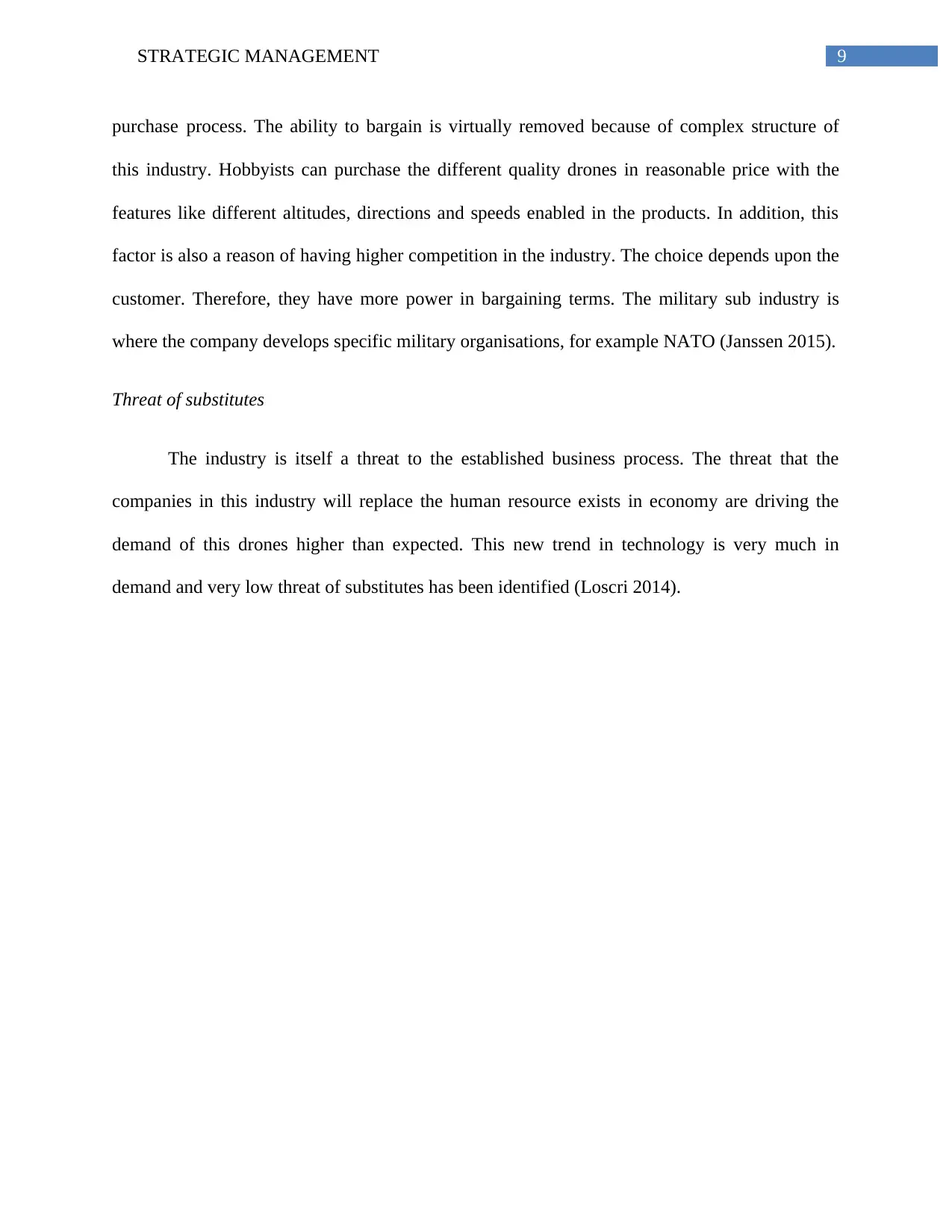
9STRATEGIC MANAGEMENT
purchase process. The ability to bargain is virtually removed because of complex structure of
this industry. Hobbyists can purchase the different quality drones in reasonable price with the
features like different altitudes, directions and speeds enabled in the products. In addition, this
factor is also a reason of having higher competition in the industry. The choice depends upon the
customer. Therefore, they have more power in bargaining terms. The military sub industry is
where the company develops specific military organisations, for example NATO (Janssen 2015).
Threat of substitutes
The industry is itself a threat to the established business process. The threat that the
companies in this industry will replace the human resource exists in economy are driving the
demand of this drones higher than expected. This new trend in technology is very much in
demand and very low threat of substitutes has been identified (Loscri 2014).
purchase process. The ability to bargain is virtually removed because of complex structure of
this industry. Hobbyists can purchase the different quality drones in reasonable price with the
features like different altitudes, directions and speeds enabled in the products. In addition, this
factor is also a reason of having higher competition in the industry. The choice depends upon the
customer. Therefore, they have more power in bargaining terms. The military sub industry is
where the company develops specific military organisations, for example NATO (Janssen 2015).
Threat of substitutes
The industry is itself a threat to the established business process. The threat that the
companies in this industry will replace the human resource exists in economy are driving the
demand of this drones higher than expected. This new trend in technology is very much in
demand and very low threat of substitutes has been identified (Loscri 2014).
Paraphrase This Document
Need a fresh take? Get an instant paraphrase of this document with our AI Paraphraser
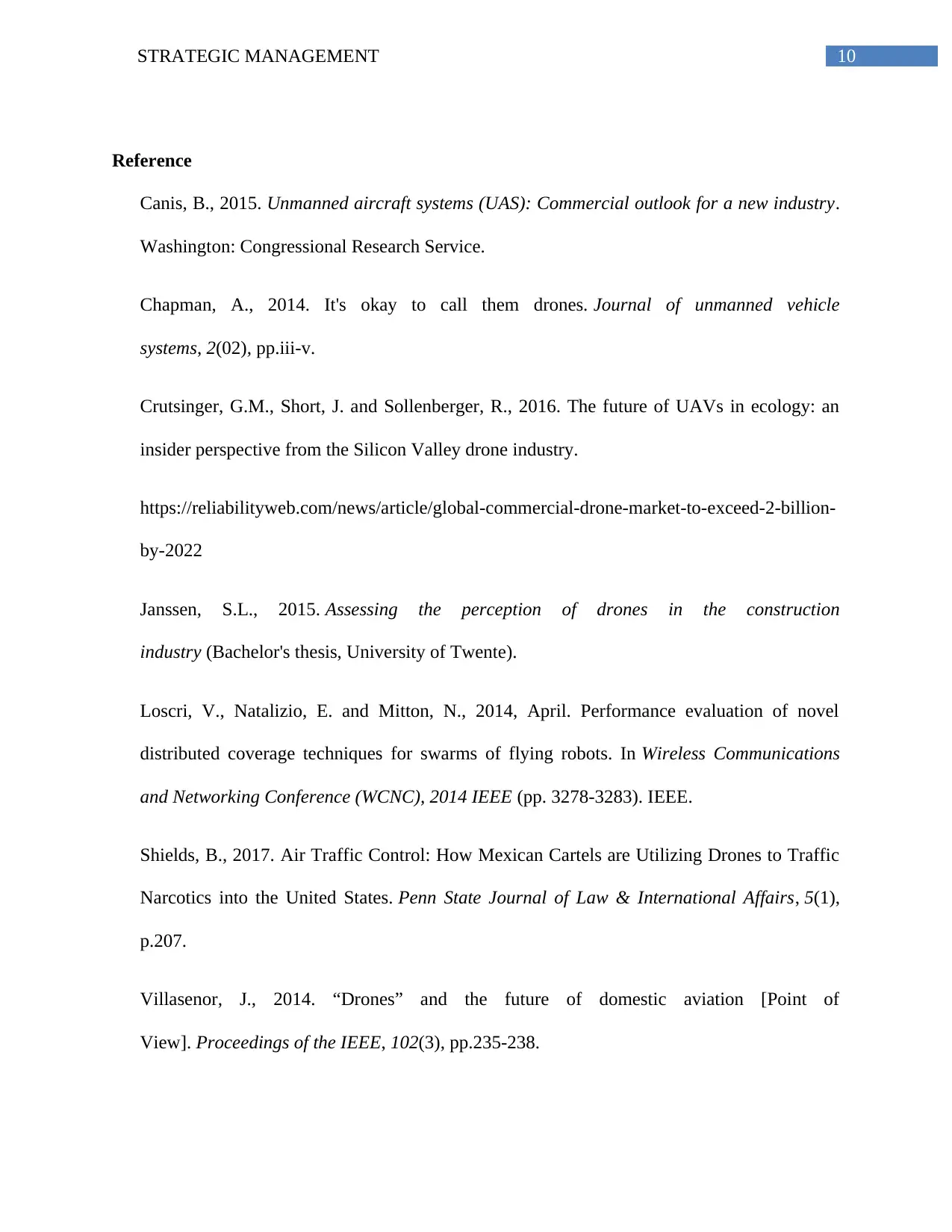
10STRATEGIC MANAGEMENT
Reference
Canis, B., 2015. Unmanned aircraft systems (UAS): Commercial outlook for a new industry.
Washington: Congressional Research Service.
Chapman, A., 2014. It's okay to call them drones. Journal of unmanned vehicle
systems, 2(02), pp.iii-v.
Crutsinger, G.M., Short, J. and Sollenberger, R., 2016. The future of UAVs in ecology: an
insider perspective from the Silicon Valley drone industry.
https://reliabilityweb.com/news/article/global-commercial-drone-market-to-exceed-2-billion-
by-2022
Janssen, S.L., 2015. Assessing the perception of drones in the construction
industry (Bachelor's thesis, University of Twente).
Loscri, V., Natalizio, E. and Mitton, N., 2014, April. Performance evaluation of novel
distributed coverage techniques for swarms of flying robots. In Wireless Communications
and Networking Conference (WCNC), 2014 IEEE (pp. 3278-3283). IEEE.
Shields, B., 2017. Air Traffic Control: How Mexican Cartels are Utilizing Drones to Traffic
Narcotics into the United States. Penn State Journal of Law & International Affairs, 5(1),
p.207.
Villasenor, J., 2014. “Drones” and the future of domestic aviation [Point of
View]. Proceedings of the IEEE, 102(3), pp.235-238.
Reference
Canis, B., 2015. Unmanned aircraft systems (UAS): Commercial outlook for a new industry.
Washington: Congressional Research Service.
Chapman, A., 2014. It's okay to call them drones. Journal of unmanned vehicle
systems, 2(02), pp.iii-v.
Crutsinger, G.M., Short, J. and Sollenberger, R., 2016. The future of UAVs in ecology: an
insider perspective from the Silicon Valley drone industry.
https://reliabilityweb.com/news/article/global-commercial-drone-market-to-exceed-2-billion-
by-2022
Janssen, S.L., 2015. Assessing the perception of drones in the construction
industry (Bachelor's thesis, University of Twente).
Loscri, V., Natalizio, E. and Mitton, N., 2014, April. Performance evaluation of novel
distributed coverage techniques for swarms of flying robots. In Wireless Communications
and Networking Conference (WCNC), 2014 IEEE (pp. 3278-3283). IEEE.
Shields, B., 2017. Air Traffic Control: How Mexican Cartels are Utilizing Drones to Traffic
Narcotics into the United States. Penn State Journal of Law & International Affairs, 5(1),
p.207.
Villasenor, J., 2014. “Drones” and the future of domestic aviation [Point of
View]. Proceedings of the IEEE, 102(3), pp.235-238.
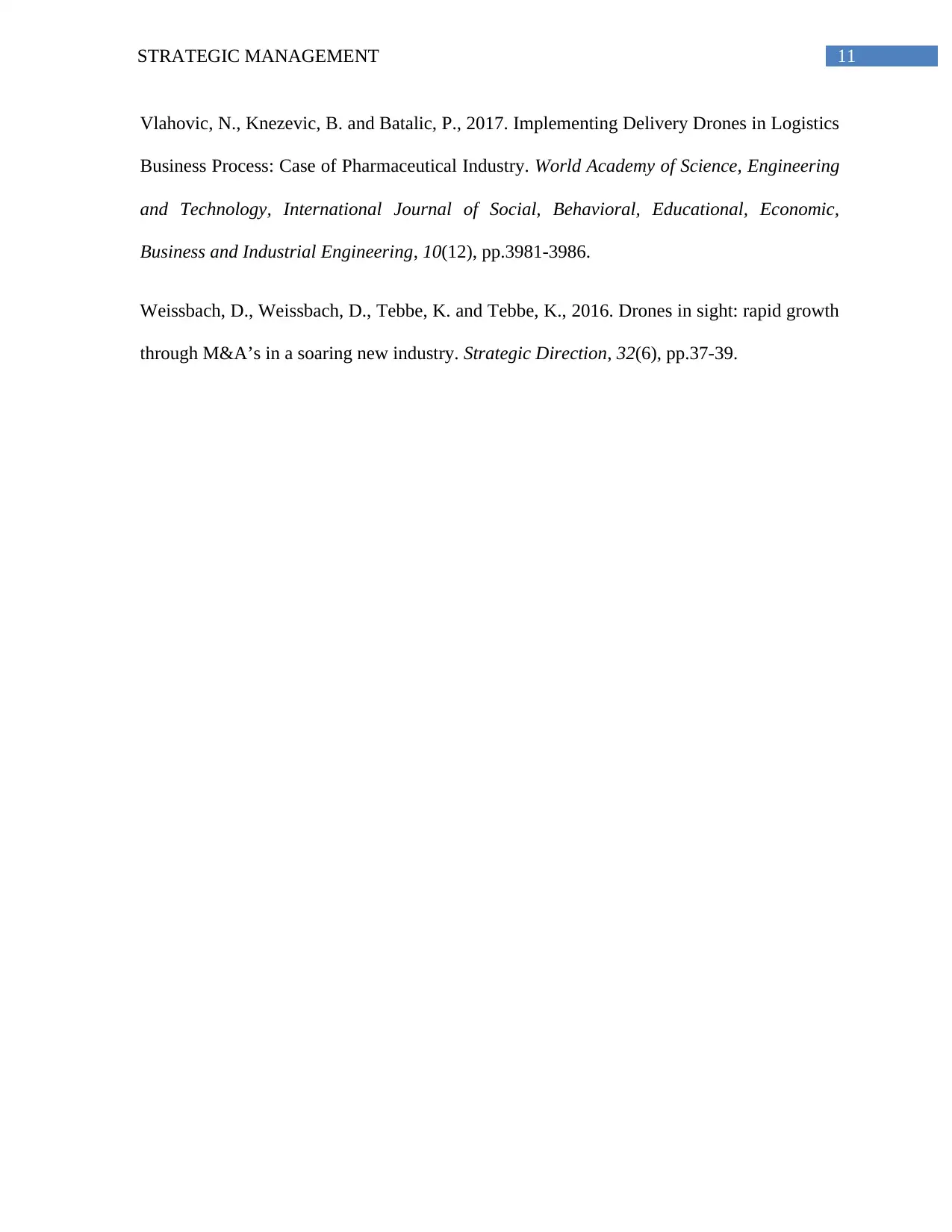
11STRATEGIC MANAGEMENT
Vlahovic, N., Knezevic, B. and Batalic, P., 2017. Implementing Delivery Drones in Logistics
Business Process: Case of Pharmaceutical Industry. World Academy of Science, Engineering
and Technology, International Journal of Social, Behavioral, Educational, Economic,
Business and Industrial Engineering, 10(12), pp.3981-3986.
Weissbach, D., Weissbach, D., Tebbe, K. and Tebbe, K., 2016. Drones in sight: rapid growth
through M&A’s in a soaring new industry. Strategic Direction, 32(6), pp.37-39.
Vlahovic, N., Knezevic, B. and Batalic, P., 2017. Implementing Delivery Drones in Logistics
Business Process: Case of Pharmaceutical Industry. World Academy of Science, Engineering
and Technology, International Journal of Social, Behavioral, Educational, Economic,
Business and Industrial Engineering, 10(12), pp.3981-3986.
Weissbach, D., Weissbach, D., Tebbe, K. and Tebbe, K., 2016. Drones in sight: rapid growth
through M&A’s in a soaring new industry. Strategic Direction, 32(6), pp.37-39.
⊘ This is a preview!⊘
Do you want full access?
Subscribe today to unlock all pages.

Trusted by 1+ million students worldwide
1 out of 12
Your All-in-One AI-Powered Toolkit for Academic Success.
+13062052269
info@desklib.com
Available 24*7 on WhatsApp / Email
![[object Object]](/_next/static/media/star-bottom.7253800d.svg)
Unlock your academic potential
Copyright © 2020–2025 A2Z Services. All Rights Reserved. Developed and managed by ZUCOL.